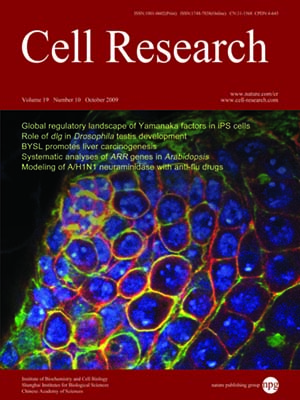
Volume 19, No 10, Oct 2009
ISSN: 1001-0602
EISSN: 1748-7838 2018
impact factor 17.848*
(Clarivate Analytics, 2019)
Volume 19 Issue 10, October 2009: 1127-1138
ORIGINAL ARTICLES
More synergetic cooperation of Yamanaka factors in induced pluripotent stem cells than in embryonic stem cells
Jinyan Huang1,*, Taotao Chen2,*, Xiaosong Liu2, Jing Jiang2, Jinsong Li2, Dangsheng Li3, X Shirley Liu4, Wei Li1,5, Jiuhong Kang1,2 and Gang Pei1,2
sup>1School of Life Sciences and Technology, Tongji University, Shanghai, China
2Laboratory of Molecular Cell Biology, Institute of Biochemistry and Cell Biology, Shanghai Institutes for Biological Sciences, Chinese Academy of Sciences, 200031 Shanghai, China
3Shanghai Information Center for Life Sciences, Shanghai Institutes for Biological Sciences, Chinese Academy of Sciences, 200031 Shanghai, China
4Department of Biostatistics and Computational Biology, Dana-Farber Cancer Insitute, Harvard School of Public Health, 44 Binney Street, Boston, MA 02115, USA
5Division of Biostatistics, Dan L Duncan Cancer Center and Department of Molecular and Cellular Biology, Baylor College of Medicine, One Baylor Plaza, Houston, TX 77030, USA
Correspondence: Gang Pei, Jiuhong Kang,(gpei@sibs.ac.cn; jhkang@tongji.edu.cn)
The role of Yamanaka factors as the core regulators in the induction of pluripotency during somatic cell reprogramming has been discovered recently. Our previous study found that Yamanaka factors regulate a developmental signaling network in maintaining embryonic stem (ES) cell pluripotency. Here, we established completely reprogrammed induced pluripotent stem (iPS) cells and analyzed the global promoter occupancy of Yamanaka factors in these cells by ChIP-chip assays. We found that promoters of 565 genes were co-bound by four Yamanaka factors in iPS cells, a 10-fold increase when compared with their binding in ES cells. The promoters occupied by a single Yamanaka factor distributed equally in activated and repressed genes in iPS cells, while in ES cells Oct4, Sox2, or Klf4 distributed mostly in repressed genes and c-Myc in activated ones. Pathway analysis of the ChIP-chip data revealed that Yamanaka factors regulated 16 developmental signaling pathways in iPS cells, among which 12 were common and 4 were unique compared to pathways regulated in ES cells. We further analyzed another recently published ChIP-chip dataset in iPS cells and observed similar results, showing the power of ChIP-chip plus pathway analysis for revealing the nature of pluripotency maintenance and regeneration. Next, we experimentally tested one of the repressive signaling pathways and found that its inhibition indeed improved efficiency of cell reprogramming. Taken together, we proposed that there is a core developmental signaling network necessary for pluripotency, with TGF-β, Hedgehog, Wnt, p53 as repressive (Yin) regulators and Jak-STAT, cell cycle, focal adhesion, adherens junction as active (Yang) ones; and Yamanaka factors synergistically regulate them in a Yin-Yang balanced way to induce pluripotency.
Cell Research (2009) 19:1127-1138. doi: 10.1038/cr.2009.106; published online 8 September 2009
FULL TEXT | PDF
Browse 2145


